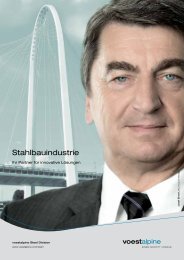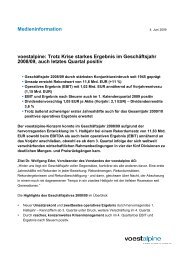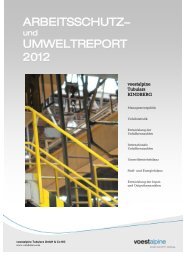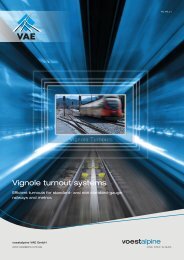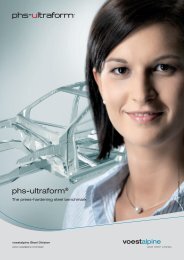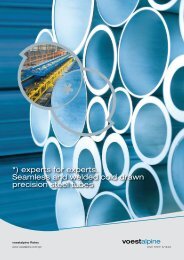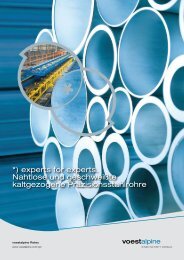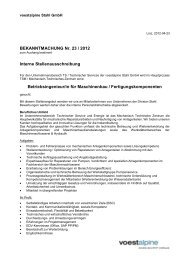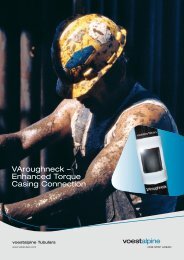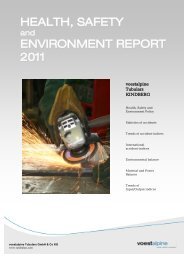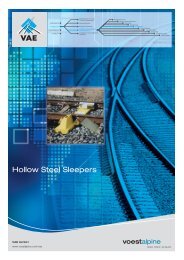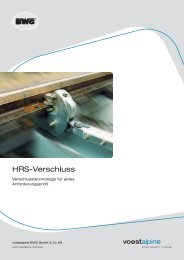Basis for Highest Quality - voestalpine
Basis for Highest Quality - voestalpine
Basis for Highest Quality - voestalpine
You also want an ePaper? Increase the reach of your titles
YUMPU automatically turns print PDFs into web optimized ePapers that Google loves.
<strong>Basis</strong> <strong>for</strong> <strong>Highest</strong> <strong>Quality</strong>Iron MakingKarl Hackl, TRR<strong>voestalpine</strong> Stahl GmbHwww.<strong>voestalpine</strong>.com/stahl/en
General„United, there is little we cannot do ...Divided, there is little we can do ...“(John F. Kennedy)Iron Making Business UnitWhat makes us successful in Iron Making: decades of expertise in metallurgy,continuous development of the process technologies and commitmenton the part of our people - the basis <strong>for</strong> outstanding steel specialties."Iron Making" (TR)This business unit comprises all the operationsand processes directly connected with producingthe iron making required <strong>for</strong> steel making.In addition, it is also responsible <strong>for</strong> the SteelDivision’s recycling as well as marketing themineral products from our plants.Human ResourcesWe place high demands on our 1,300 employees- both physically and mentally. Although productionmay look archaic, the technologies used aremostly state-of-the-art.In particular, we promote training, development,occupational health and safety and Life Programinitiatives to create an attractive workingenvironment.Production ProcessIn the coking plant at the works, the imported coking coal is made into blast furnace coke. Thesintering plant agglomerates iron ore fines (dust) together with lime chippings, breeze and recycledmaterials into blast furnace sinter, which is then used with lump ores, pellets, recycled materials andreducing agents (blast furnace coke, oil, gas, plastics, etc.) to produce pig iron, slag and gas.Slag <strong>for</strong>ming during iron making is processed into high quality construction materials at the recyclingcenter.Plant engineering, technology, raw materials and segment management support the main operations tooptimize production processes.Human ResourcesWage EarnersSalaried EmployeesIron Making Business Unit / Segment Management 0 23Plant Engineering 206 51Recycling Center 131 28Blast Furnace 293 30Coking Plant 218 22Raw Material Supply/Sintering Plant 180 16Steyrling Lime Plant 42 8Technology 2 32Total 1.072 * 210 ** of which 752 part time, as per July 2012 (source: PDWH)Page 2 Page 3
Raw Materials Management and SupplySintering PlantRaw Materials Management and SupplySintering PlantTogether we supply the TR Iron Making Business Unit with some 11 milliontons of raw materials - coal, ores, pellets, coke, oil, lime and breeze.We produce 2.8 million tons of sinter annually in compliance with stringentenvironmental regulations.Raw Materials ManagementRaw Material SupplyProduction ProcessPlant Description“A key successfactor iscooperatingwith theproductioncompanies andRaw MaterialsManagement.”Thomas KutsamTRRRaw Materials Management is the central point ofcontact <strong>for</strong> technical, operational quantity planningand ensures economic, strategic decisions.Its responsibilities include:■■Burden planning coordination■■Raw materials logistics planning■■Material requirements planning■■Supply chain tracking■■■■Monitoring and planning the net workingcapital <strong>for</strong> the raw materialsSlab cost optimization - central coordinationand preparation <strong>for</strong> making decisions regardingimproved raw material use and mostcost-effective operation mode in the area ofmetallurgyThis segment supplies the main facilities - cokingplant, sintering plant and blast furnace - with suchraw materials as coal, ore, pellets, coke, cokebreeze, lime and aggregates.All the raw materials received <strong>for</strong> TR are unloaded,stored and delivered as required - a volume of over11 million metric tons a year. This huge amount ishandled at three different storage areas with sixgantry cranes and several unloading tracks. Thispresents a not inconsiderable challenge - also inview of the highly volatile incoming goods andweather conditions, including extreme cold, floodsand low water.Sintering means agglomerating (<strong>for</strong>ming lumpsby fusing together) powdered iron ore mixed withrecycled materials and additives. Coke breeze isadded and the mixture deposited on a travelinggrate (sinter strand). Gas burners ignite thecombustible material.Air is drawn down and waste gas from theprocess partially returned, moving the burningzone along to the end of the sinter strand at thebottom of the grate.The process is controlled to ensure the burnthroughpoint is the optimum in terms of productivityand quality. Be<strong>for</strong>e the occurring waste gasleaves the plant, it is dedusted, desulfurized,denitrided and the heavy metals are removed.The sintering plant in Linz incorporates the latestprocess and environmental technology. Since 1990,new technologies have been developed andinstalled in the Linz plant <strong>for</strong> the first time in theworld:■ 1990 sinter strand widened and greatestcharge depth■ 1993 sinter waste gas dedusting withAirfine scrubber■ 2005 eposint selective waste gas recycling andsinter strand lengthened■ 2007 MEROS dry treatment <strong>for</strong> sinter waste gas■ 2013 first DeNOx system <strong>for</strong> sinter waste gastreatment in Europe“As the processbecomesincreasinglycomplex, ourstaff’squalificationsalso have tokeep pace.”Erwin ZwittagTRRPage 4 Page 5
Coke OvenSteyrling Lime PlantCoking PlantSteyrling Lime PlantIn our coking plant - the only one in Austria - we produce about 1.4 milliontons of coke from 1.9 million tons of coal.Approximately 1.2 million tons of limestone is quarried in Steyrling annually.Production ProcessPlant DescriptionMining and Calcining“To cool thecoke, weneed about12,000 liters ofwater every fiveminutes.”Erwin GüntherTRKA special, low-sulfur coal mixture is heated inairless coking chambers at over 1,260°C. Thisexpels the volatile constituents from the coal. Thepure coke is discharged from the chamber andquenched with water.Volatile coal constituents are treated and thenused as fuel gas in the works. The by-productsobtained when purifying the coke gas such asbenzene, sulfuric acid and tar are used in thechemical industry. Sulfuric acid and tar are alsorecycled in the metallurgical processes.All the coke oven batteries in use have beenrelined over the course of time and fitted with thelatest filters and treatment systems. In an ovengroup five batteries of 40 ovens each are operated.The various coal discharging, crushing andmixing systems are designed to enable optimalblends of a wide range of coal qualities to beused.When it comes to environmental protection, thecoking plant at <strong>voestalpine</strong> Stahl in Linz isregarded as exemplary in Europe.At the Steyrling plant limestone is extracted by bench quarrying. The rock is blasted andthe material crushed by a jaw crusher to a particle size of < 250 mm. It is transportedthrough a system of shafts and tunnels to ground level at 550 m.Material up to 20 mm in size goes to the sintering plant in Linz, while the lumps up to70 mm are processed to produce quicklime. In this process the washed limestone is burnedwith natural gas at around 1,000°C, causing it to lose 44% of its weight. The burnt lime orquicklime is hauled in closed railcars to Linz, to Donawitz and Kapfenberg by lorries within24 hours.“The bestmethod oftransportdownhill isgravity.”Wilfried PeyfußTRSSteyrling lime plant videoPage 6 Page 7Un<strong>for</strong>tunately it is only available in German but nevertheless we invite you to watch it.
Blast FurnaceBlast FurnaceBlast FurnaceOur three blast furnaces smelt 4.7 million tons of pig iron annually - with newtechnologies enabling us to substantially reduce carbon emissions.“There arethree keysub-processes:hot air blasting,pig ironsmelting andservice.”Gerhard PillmairTRHProduction ProcessThe most important materials <strong>for</strong> iron making are sintered, pelletized or lump iron ores <strong>for</strong> the furnacecharge (called burden) with coke <strong>for</strong> heating. On blowing in hot air at around 1,200°C gases are<strong>for</strong>med which are capable of releasing the iron from the burden (reducing).What is left after the blast furnace process is molten pig iron (1,440 - 1,470°C) and molten slag, whichare removed in discontinuous intervals (tapping). The slag is mainly granulated with water and used<strong>for</strong> manufacturing cement or as construction material. Additionally combustible blast furnace gas<strong>for</strong>ms, which we use <strong>for</strong> heating the air and in the plant’s energy network.The pig iron is processed in the steel mill to produce top-quality steel.Pig IronThe term pig iron arose from the fact that the melt contains beside iron (roughly 94%) carbon, silicium,manganese, phosphorus and sulfur.Furnace CycleA cycle is the operating time after whicha blast furnace needs repairs.Thanks to modernization, we now expectcycles of over 12 years <strong>for</strong> blast furnaces5 and 6 and 14 years <strong>for</strong> blast furnace A.Over this long period the furnaces arealmost constantly in use. Blast furnace Aproduces roughly 40 million tons of pigiron.Blast furnace videoUn<strong>for</strong>tunately the video is only available in German but nevertheless weinvite you to watch it.Page 8 Page 9
Recycling CenterRecycling CenterRecycling CenterRecycling Center Sales"All commercialcementcontainsaround 15- 60% blastfurnace slag."Andreas KuttnerTRWWe use special processes to turn 2 million tons of slag, the by-product fromsmelting, into valuable building materials.The independent Recycling Center is divided into the areas of slag, lifecycle management and sales.We either sell the products to external customers, store them at local storage sites or recycle them atthe plant.Given the high standard of quality, customers are assured an extremely good cost-benefit ratio. TheRecycling Center sells quality products — meeting customer demands and protecting the environment(conserving natural resources).SlagsAn in-depth understanding of the chemicalcomposition of various types of slag, years ofexperience in processing and the constant search<strong>for</strong> new applications ensure that sales of the slagoccurring during steel production meet targets.■■■■■■Blast furnace slag, once rapidly cooled withwater, solidifies to very glassy granulated slagsand with distinct latent hydraulic properties.LD slag is one of the best materials <strong>for</strong> roadbuilding due to its durability and high grip.Ladle slag occurs when steel is subsequentlytreated to achieve the required degree ofpurity.Lifecycle ManagementLifecycle Management coordinates handling ofall the waste and also processes by-products <strong>for</strong>further use. The main focus is on conservingresources by recycling. Processing is divided intothree areas: preselection, magnetic separationand sizing (screening).The sales team of the Recycling Center markets furnace by-products with avalue of € 38 million per year.Products and ApplicationsBlast furnace and LD slagRaw tar, light oil (coal)Breakwater stonesQuicklimeIron sulfateIron oxideCement industry, road building, corrosion protection, insulation, road grit,fertilizer industryChemical industry / distillationProcurement of alternative reducing agentsPlastics, waste oilIndustrial usesSteel mill dustRiver control, avalanche barriers, erosion protectionSewage plants, neutralization, building trade, chemical industryWastewater treatment, phosphate removal, raw material <strong>for</strong> high-qualitypigments, cement industryHard and soft ferrite industry with the highest demands, pigment industryPage 10 Page 11
TechnologyTechnologyTechnologyWe invest around € 5 million in research & development and support businessunit management in achieving strategic goals.Iron Making Technology consists of three areas:research & development, process automation andinvestment planning.Our core business is project management. We arethere<strong>for</strong>e capable of realising many ideas fromconcept to implementation by ourselves. An ideamay, <strong>for</strong> example, start with an R&D project <strong>for</strong>which a potential solution is found.We then carry out technical and financialfeasibility studies in cooperation with our projectprofessionals, be<strong>for</strong>e finally embarking on theactual project. As a result, we play a key role inimproving sustainable processes.Research & DevelopmentOne focus of development work is processsimulation and quality control <strong>for</strong> raw materials.Investment PlanningOur business is projects. Here we coordinate allthe capital expenditure in the business unit andthe Steel Division.We also manage all technological investmentsrelevant to the business unit. This includesproject management and supervising thenecessary operations from the pre-project phasethrough handover.Process AutomationProcess Automation supports the Iron Making insolving their IT issues.Seven automation systems are in use around theclock seven days a week in order to optimizeproduction processes in terms of costs andquality.Iron Making Technical CenterIt is a state-of-the-art facility with all the test equipment required <strong>for</strong> analyzing and evaluating the rawmaterials used in the processes in the coking plant, sinter plant, blast furnace and the materialsrecycled by-products. The pilot plants <strong>for</strong>m the basis <strong>for</strong> research and development projects in the IronMaking business segment and <strong>for</strong> alternative smelting reduction processes.Test FacilityTest sintering pan with waste gas recirculationand analysis, mixer, rotating drum,pelletizer (0.4 and 1 m diameter), cokingretort with condensation apparatus andwaste gas analysis, compulsory mixer,Mogensen sizer, crushing of secondary rawmaterials.Physical TestsCrushing; screen analysis; finest particle analysis;briquetting behavior; density determination;true-, gross-, bulk density; cold crushing strength;drum strength; permeability of fills; magneticseparation; mixing behavior; viscosity.Process TestsCoke reactivity (CRI/CSR); low-temperaturedisaggregation (RDI), reducibility, softening andmelting behavior (REAS) of iron girders. Degrading-,sticking-, clustering- and swelling behaviorof iron girders; slag steam test, rotary furnaceand high-temperature processes."We also callcompanysupportjust-do-itprocesses.”Thomas BürglerTRTThe processes can also be visualized worldwideon the internet.Page 12 Page 13
Plant EngineeringSegment ManagementPlant EngineeringSegement ManagementWe maintain and improve the efficiency of our facilities with a budget of€ 63 million.Segment Management coordinates and manages the non-technical tasks <strong>for</strong>about 1,300 employees.“We supplythe technicalexpertise.”Rudolf WimbergerTRAOur aim is to ensure the required availability ofthe production facilities at minimal cost. Thisincludes continuous improvement of efficiencyand cost-effectiveness according to the principlesof total productive maintenance (TPM).The Steel Division’s maintenance strategy <strong>for</strong>msthe basis of our work. We include the individualmaintenance processes in our integrated plantmanagement, evaluate them regularly and reportresults in key per<strong>for</strong>mance indicators (KPI).Our people cover the areas of mechanical andelectrical engineering, measuring and controltechnology process, supplemented with specialplant and production know-how. This knowledgeis maintained with regular training.Employees of the production companies providedefined maintenance tasks and support theservice and repair teams. Flexible working hoursand close cooperation with the central servicecompanies and external contractors allow a widerange of repair services.In addition to standard maintenance PlantEngineering provides expertise <strong>for</strong> planning,installing and commissioning of new plants.Controlling– in close contact with central and local executivesand ensures the division’s success in bothfinancial and strategic terms. It includes mediumand long-term planning, analyses, key per<strong>for</strong>manceindicators, etc.HR Management– responsible <strong>for</strong> operational human resources(HR) work, covering strategic HR planning andrecruiting, HR and organization development.Other tasks: working methods, bonus systems,working hours schemes, etc.Integrated Management Systems (IMS)– coordinates standard operating procedures andguidelines, deals with development, implementationand maintenance in relation to quality,environment, health and safety.Special Tasks– includes activities of high strategic importancesuch as the continuous improvement process(CIP), management of the strategic HR pool,knowledge management and internal andexternal public relations (e.g. news <strong>for</strong> thebulletin board, in<strong>for</strong>mation events, etc.).“Segmentmanagementcovers allnon-technicalactivities.”Rudolf AbelTRCPage 14 Page 15
<strong>voestalpine</strong> Stahl GmbH<strong>voestalpine</strong>-Straße 34020 Linz, AustriaT. +43/50304/15-5956F. +43/50304/55-2597margarete.punzet@<strong>voestalpine</strong>.comwww.<strong>voestalpine</strong>.com



